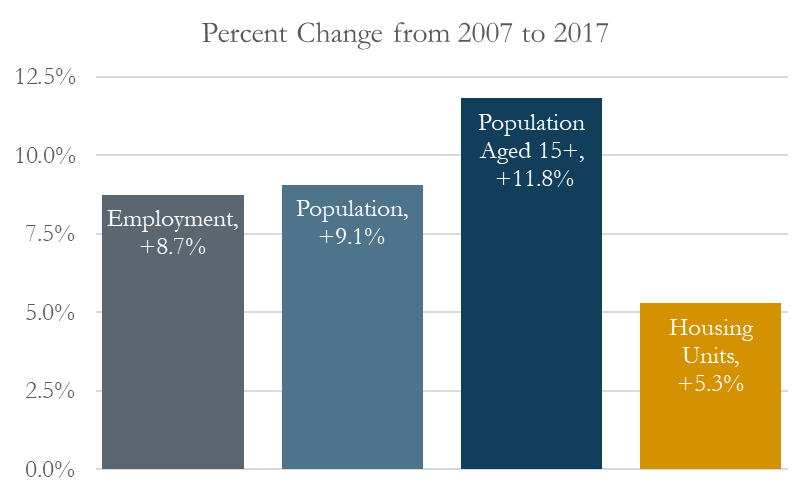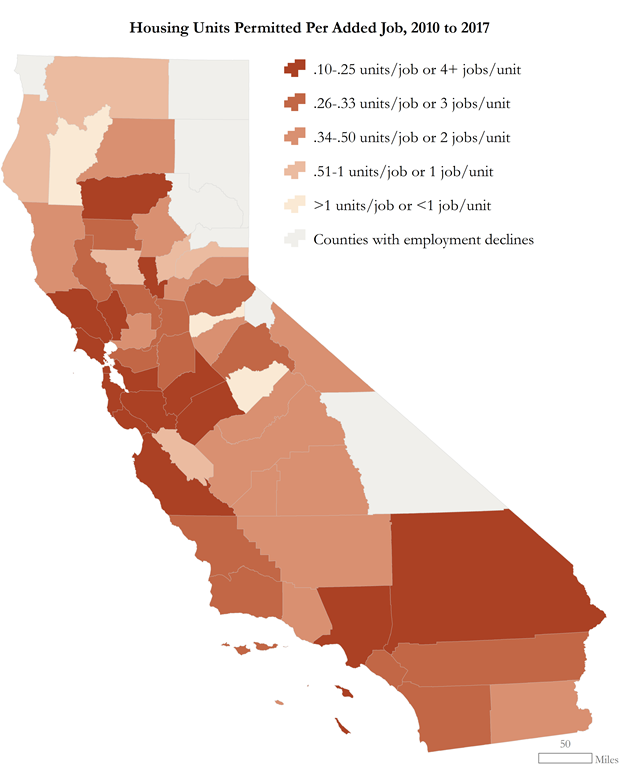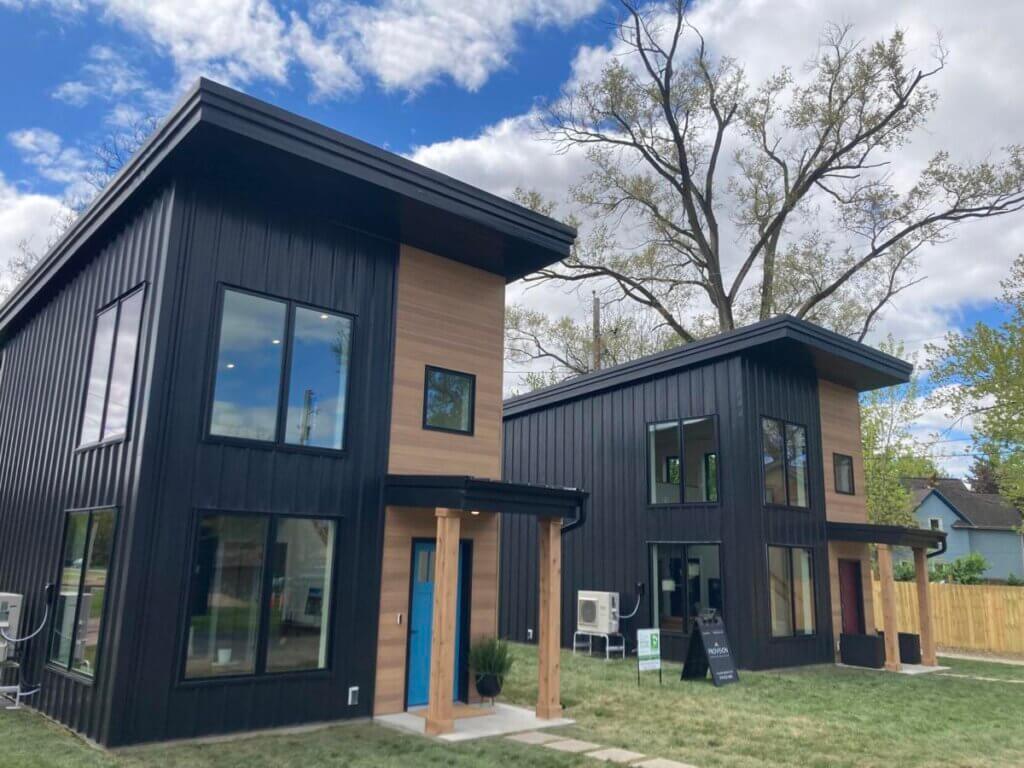Housing Policies in California Cities: Seeking Local Solutions to a Statewide Shortfall
Published On March 1, 2019
By Dr. Sarah Mawhorter, Postdoctoral Scholar at the University of Southern California and Visiting Scholar at Syracuse University
This is the first installment in a working paper series that utilizes the Terner Center California Residential Land Use Survey to assess the implications of California’s state and local policy for housing. The working paper series is published jointly by the CALIFORNIA ASSOCIATION OF REALTORS®’s Center for California Real Estate and the Terner Center for Housing Innovation at UC Berkeley. This paper series will examine a number of topics related to land use regulation; from the feasibility of ADU production to trends in segregation. Read the full paper here.
After decades of lagging housing production, Californians face some of the highest rents and home values in the country. By my estimate, the state fell short of meeting its housing need by more than 1.1 million units between 2007 and 2017 alone (Figure 1). (1)
Figure 1. Percent Change in California Population, Employment and Housing Units from 2007 to 2017




Viewed at the state level, this shortfall appears daunting, but the research in this working paper suggests that local jurisdictions can draw on an arsenal of regulatory policies to encourage development. The paper uses a new data resource—the Terner California Residential Land Use Survey—in tandem with other publicly-available data on housing, employment, and demographic trends to address three main research questions:
- What city characteristics enable or inhibit housing development, across various types of California cities?
- Which local housing policies are associated with housing development?
- How severe is the housing development shortfall in different parts of California, and what are the implications for young adults wanting to move out on their own?
The paper finds the following:
Housing development patterns are associated with housing stock and housing market characteristics, employment access, commuting patterns, and demographic composition, though the factors that matter differ for single-family and multifamily development.
Overall, more new housing was built in cities with greater access to jobs, but less new housing was built in cities with older housing, higher homeownership rates, and higher vacancy rates.
For single-family production, more single-family housing was built in lower-middle-density cities with higher housing prices, while less single-family housing was built in cities with older housing, higher homeownership and vacancy rates, larger non-Hispanic White populations, and more commuters who take transit, bicycle, or walk to work.
In the case of multifamily development, more housing was built in higher-density cities with greater employment access, while less multifamily housing was built in cities with older housing, higher homeownership rates, and higher vacancy rates.
Local land use policies and planning practices are linked with increased housing development in some cases, and decreased housing development in others. Single-family homes appear to be particularly affected.
Cities with longer approval times for affordable housing projects had less development overall. Less multifamily housing was built in cities with higher parking requirements and more land devoted to single-family housing, while building caps and land supply constraints were also associated with reduced single-family development.
More single-family homes were built in cities with inclusionary housing incentives, higher approval rates, more land zoned for non-residential uses, and cities subject to urban growth boundaries. Unsurprisingly, more single-family housing was built in cities that annexed land.
Housing growth lagged far behind job growth, and the discrepancy was especially stark in the San Francisco Bay Area and the greater Los Angeles region.
Counties in the metropolitan regions of the San Francisco Bay Area and Los Angeles had a particularly striking disconnect between job and housing growth (Figure 2). The City and County of San Francisco, for example, gained only one housing unit for every 6.7 jobs added between 2010 and 2017.
Figure 2. Map of Housing Units Permitted Per Added Job in California Counties, 2010 to 2017


Amid housing shortfalls, young people are forming fewer households and buying fewer homes.
While housing supply lagged, the median home value in California increased by 7.9% over a five-year period. This average obscures even higher local increases; San Francisco saw an increase of 15.4%, surpassed only by Alameda County (17.8%) and Santa Clara County (18.1%). Median gross rents also increased dramatically, rising by 5.0% statewide and by as much as 19.6% and 21.1% in San Mateo and Santa Clara Counties, respectively.
The rising home prices of the last decade have been accompanied by declining rates of household formation by young adults in their late 20’s and early 30’s, historically an age when many have moved out on their own and even started to pursue homeownership. (2), (3), (4) Across the state, per capita headship rates for young adults fell by 2.9% between 2008-2012 and 2013-2017, with ownership rates dropping by 1.3% and rentership rates falling by 1.6%.
Indeed, in all the counties I reviewed, per-capita headship, per-capita homeownership, and per-capita rentership rates for young adults fell over a five year span, with the exception of the rate of ownership in San Francisco which remained steady at a low 5.6%. Within the Association of Bay Area Governments, headship, ownership, and rentership rates for young adults dropped by 3.5%, 1.2%, and 2.2%, respectively. The Southern California Association of Governments saw similar trends among young adults; headship rates fell by 3.1%, ownership rates fell by 1.6%, and rentership rates fell by 1.5%.
Steep housing prices acutely affect young adults, and the compromises they make to afford housing now will continue to impact their lives well into the future. (5), (6)
It is crucial for local governments to help solve this problem by implementing policies that enable and encourage more housing development.
This research suggests there are ways in which jurisdictions can positively influence production of housing. Several best practices highlighted in the paper include:
- Zoning for multifamily development
- Reducing parking requirements for multifamily housing
- Shortening approval timelines
- Raising approval rates
- Encouraging inclusionary housing
By making better use of policy tools that work, policymakers can protect the stability, independence, and financial future of the next generation of Californians.
Notes
(1) Other estimates of current and projected housing needs are similar in magnitude. A 2018 study by the California Department of Housing and Community Development estimated a statewide shortfall of more than 1 million homes affordable to extremely- and very low-income households, and predicted that the state needed to add 1.8 million homes between 2015 and 2025 to meet projected growth. In 2016, The McKinsey Global Institute estimated that California needed to add 3.5 million units by 2025 to address the current shortfall and house its future residents.
(2) Clark, W. A. V., Deurloo, M. C., & Dieleman, F. M. (2003). Housing Careers in the United States, 1968-93: Modelling the Sequencing of Housing States. Urban Studies, 40(1), 143–160. https://doi.org/10.1080/00420980220080211
(3) Clark, W. A. V., & Dieleman, F. M. (1996). Households and Housing: Choice and Outcomes in the Housing Market. Center for Urban Policy Research.
(4) Myers, D. (1983). Upward Mobility and the Filtering Process. Journal of Planning Education and Research, 2(2), 101–112. https://doi.org/10.1177/0739456X8300200206
(5) Clapham, D. (2005). The meaning of housing: a pathways approach. Bristol, UK: The Policy Press.
(6) Mendenhall, R., Kramer, K. Z., & Akresh, I. R. (2014). Asset Accumulation and Housing Cost Burden: Pathways to (Not) Saving. Housing Policy Debate, 24(2), 387–414. https://doi.org/10.1080/10511482.2013.838981





